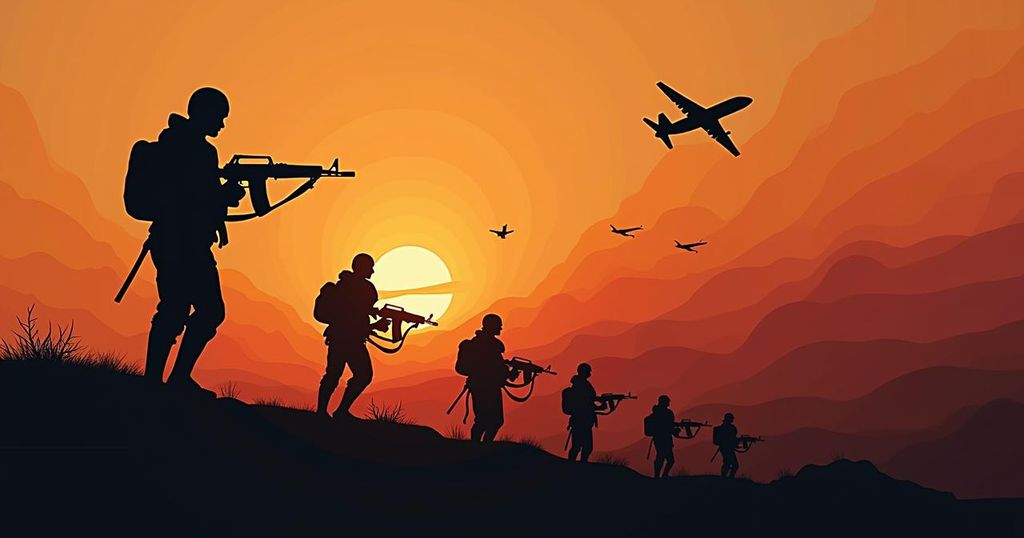Analysis of the Escalating Conflict Following the Killing of Hezbollah Leader Hassan Nasrallah

Recent events in the Middle East saw Israel’s airstrikes kill Hezbollah leader Hassan Nasrallah, escalating tensions and raising fears of a wider regional conflict. This represents a significant loss for Hezbollah amidst ongoing military actions against Israel, which has intensified following the start of its war against Hamas. The humanitarian situation in Lebanon is dire, with many civilians displaced and casualties mounting. As both sides assess their strategies, the potential for further escalation looms large, with Iran’s involvement posing additional complexities.
In the recent escalation of hostilities in the Middle East, Israeli airstrikes resulted in the death of prominent Hezbollah leader Hassan Nasrallah, a significant event that has raised concerns regarding a potential wider regional conflict. The airstrikes targeted Nasrallah’s underground headquarters in Beirut, marking a severe increase in the ongoing conflict between Israel and Hezbollah, a militant group that has been engaged in attacks against Israel since the beginning of its war against Hamas in Gaza. This incident represents one of several recent losses for Hezbollah, which has suffered casualties among its leadership and personnel. Israel has indicated that it is entering a new phase of warfare, with its operations now focused on the northern front, particularly along the Lebanon border. Their stated goals include the safe return of Israeli civilians who have been displaced due to the violent altercations. As a consequence of the escalating violence, hundreds of thousands of Lebanese civilians have been displaced, with deaths numbering over a thousand according to local officials. Israel has hinted at the possibility of a ground invasion, which would mark its fourth military incursion into Lebanon within five decades. In response, Hezbollah has vowed to persist in its struggle against Israel, while Iran, which provides support to Hezbollah as part of its broader strategic alliances, reaffirmed its solidarity with the group. The airstrikes conducted by Israel led to significant destruction in densely populated regions, prompting mass evacuations. Despite Israel’s assertions of Hezbollah using civilian areas for military purposes, Lebanese civilians reported that the group operates in secrecy, making compliance with warnings issued by the Israeli military impractical. The Israeli leadership recently rejected proposals for a ceasefire initiated by the United States and France. Following these developments, the United States distanced itself from the airstrikes, with President Biden commenting that Nasrallah’s death was a “measure of justice” while urging de-escalation in the area. Although the U.S. recognizes the potential for an Israeli ground incursion, the final decision remains uncertain. In the aftermath of Nasrallah’s assassination, Hezbollah is likely to reevaluate its strategies and communication methods, assessing how to adapt in light of the ongoing Israeli strikes that have purportedly weakened its military capabilities. Analysts express that while Hezbollah has sustained substantial losses, it retains significant resources, including advanced long-range missiles that could affect Israeli infrastructure. As of the present situation, there has been no overwhelming response from Hezbollah in terms of launching a significant barrage of attacks against Israeli targets. However, the assassination of Nasrallah is anticipated to provoke a strong retaliation. Former intelligence officials indicate that such a response has the potential to escalate tensions, possibly leading to a full-scale war. Another pivotal aspect is Iran’s anticipated reaction. While Iran has exhibited caution regarding direct confrontations with Israel, it may enter the conflict should it perceive Hezbollah is facing imminent defeat. The implications of such involvement could further entangle the United States in the conflict. Iran has condemned Nasrallah’s killing, labeling it a catalyst for a shift in the conflict’s dynamics and asserting that consequences will follow for the aggressors. The possibility for diplomatic efforts seems diminished as ongoing conflicts involving Israel, Hezbollah, and Hamas show no signs of resolution. Experts suggest that without significant changes in the diplomatic landscape, any resolutions would likely revolve around management and deterrence rather than transformative solutions.
The article discusses the recent escalation of conflict between Israel and Hezbollah in Lebanon, particularly following the Israeli airstrike that resulted in the death of Hezbollah leader Hassan Nasrallah. This event marks a crucial juncture in a series of confrontations that have escalated tensions not only between Israel and Hezbollah but also with Iran, which supports the militant group. The backdrop of this conflict is the ongoing war between Israel and Hamas in Gaza, which has drawn Hezbollah into its own series of military actions against Israel. The broader implications of these hostilities raise fears of a potential regional war in the Middle East, compounded by the significant humanitarian crisis unfolding in Lebanon due to the violence.
In conclusion, the assassination of Hassan Nasrallah represents a turning point in the conflict between Israel and Hezbollah, with the potential to incite further escalation. The situation remains precarious, as the humanitarian toll in Lebanon exacerbates the already volatile dynamics of the region. Diplomatic avenues appear limited, and the possibility of broader conflict remains a serious concern as both Israel and Hezbollah reassess their military strategies in response to recent developments. The involvement of Iran could significantly influence future conflicts, further complicating the regional landscape.
Original Source: www.cnn.com








